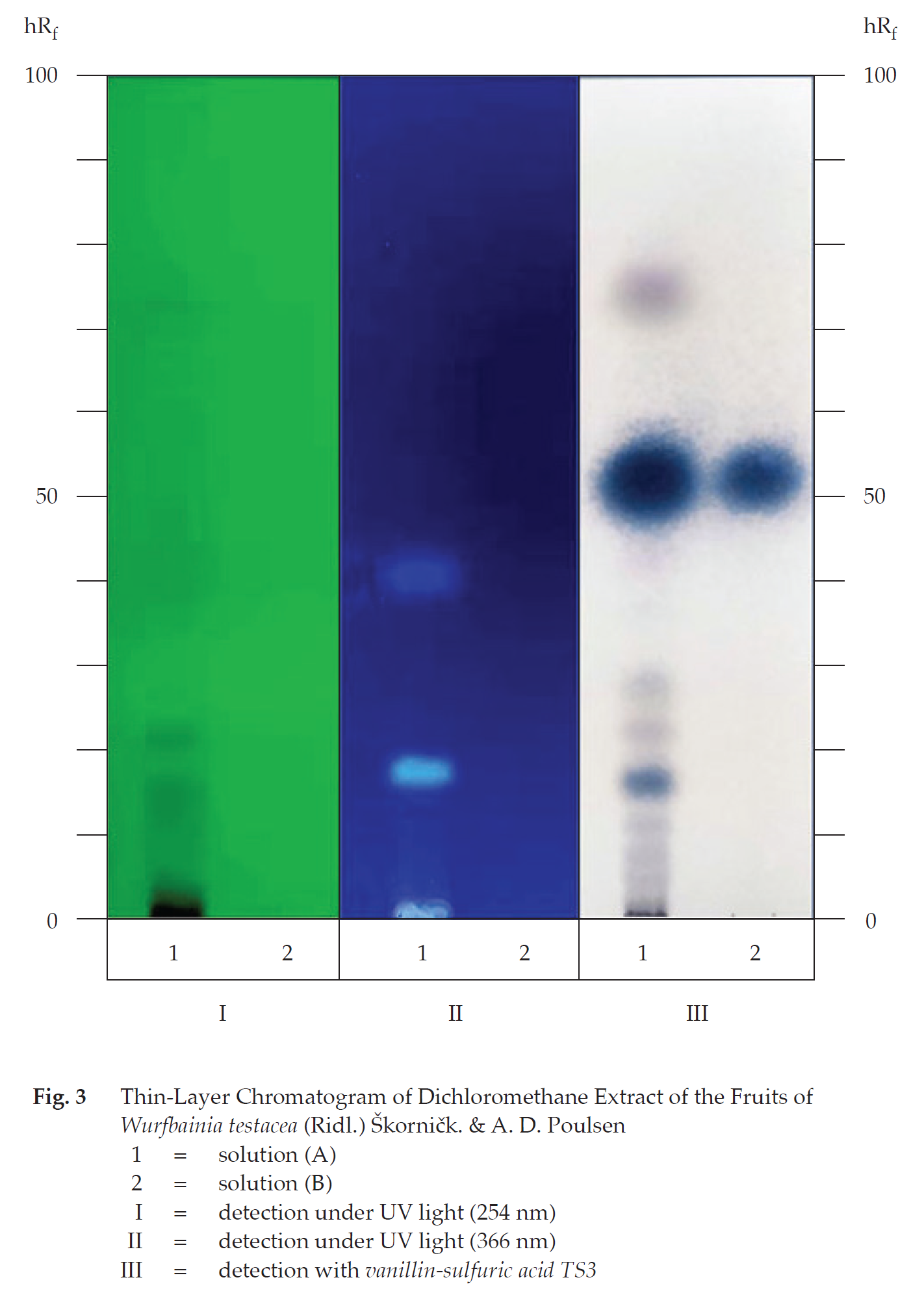ตำรามาตรฐานยาสมุนไพรไทย
Thai Herbal Pharmacopoeia
สำนักยาและวัตถุเสพติด กรมวิทยาศาสตร์การแพทย์ กระทรวงสาธารณสุข
Bureau of Drug and Narcotic, Department of Medical Sciences, Ministry of Public Health(Tinospora crispa (L.) Hook.f. & Thomson)
(Nelumbo nucifera Gaertn.)
(Centella asiatica (L.) Urb.)
(Centella Dry Extract)
(Centella Cream)
(Mesua ferrea L.)
(Piper sarmentosum Roxb.)
(Piper sarmentosum Roxb.)
(Pterocarpus santalinus L. f.)
(Santalum album L.)
(Senna tora (L.) Roxb.)
(Senna alata (L.) Roxb.)
(Senna Alata Tea)
(Piper retrofractum Vahl)
(Myristica fragrans Houtt)
(Andrographis paniculata (Burm. f.) Nees)
(Andrographis Capsules)
(Allium ascalonicum L.)
(Ocimum tenuiflorum L.)
(Curcuma longa L.)
(Turmeric Capsules)
(Turmeric Dry Extract)
(Turmeric Dry Extract Capsules)
(Arcangelisia flava (L.) Merr.)
(Curcuma sp.)
Harrisonia perforata (Blanco) Merr.
(Aristolochia pierrei Lecomte)
(Zingiber officinale Roscoe)
(Ginger Capsules)
(Ginger Tea)
(Cassia fistula L.)
(Nardostachys jatamansi (D. Don) DC.)
(Angelica sinensis (Oliv.) Diels)
Artemisia annua L.
(Ligusticum sinense Oliv. cv. Chuanxiong)
(Neopicrorhiza scrophulariiflora Pennell)
(Atractylodes lancea (Thunb.) DC.)
(Aucklandia lappa Decne)
(Terminalia chebula Retz.)
(Angelica dahurica (Hoffm.) Benth. & Hook. f. ex Franch. & Sav. var. dahurica)
(Kaempferia parviflora Wall. ex Baker)
(Hibiscus sabdariffa L.)
(Roselle Tea)
(Allium sativum L.)
(Zingiber zerumbet (L.) Sm.)
(Wurfbainia testacea (Ridl.) Škorničk.& A. D. Poulsen)
(Cannabis sativa L.)
(Myristica fragrans Houtt)
(Dracaena cochinchinensis (Lour.) S. C. Chen)
(Ficus racemosa L.)
(Hyptis suaveolens (L.) Poit.)
Clerodendrum indicum (L.) Kuntze
(Phyllanthus emblica L.)
(Citrus hystrix DC.)
(Citrus hystrix DC.)
(Areca catechu L.)
(Momordica charantia L.)
Moringa oleifera Lam.
(Aegle marmelos (L.) Corrêa)
(Solanum trilobatum L.)
(Morus alba L.)
Gynostemma pentaphyllum(Thunb.)
Makino
(Clinacanthus nutans (Burm. f.) Lindau)
(Cissus quadrangularis L.)
(Mimusops elengi L.)
(Zingiber montanum (J. König) Link. ex A. Dietr.)
(Piper betle L.)
(Capsicum annuum L.)
(Capsicum Oleoresin)
(Capsicum Gel)
(Piper nigrum L.)
(Piper nigrum L.)
(Eurycoma longifolia Jack)
(Thunbergia laurifolia Lindl.)
(Piper wallichii (Miq.) Hand.-Mazz.)
Senna garrettiana (Craib) H. S. Irwin & Barneby
(Terminalia bellirica (Gaertn.) Roxb.)
(Terminalia chebula Retz.)
(Caesalpinia bonduc (L.) H. Roxb.)
(Tarlmounia elliptica (DC.) H. Rob., S. C. Keeley, Skvaria & R. Chan)
(Hog Creeper Vine Dry Extract Capsiles)
(Hog Creeper Vine Dry Extract)
(Brachypterum scandens (Roxb.) Miq.)
(Lepidium sativum L.)
(Nigella sativa L.)
(Cuminum cyminum L.)
(Foeniculum vulgare Mill.)
(Plantago ovata Forssk.)
(Pimpinella anisum L.)
(Carum carvi L.)
(Anethum graveolens L.)
(Trachyspermum ammi (L.) Sprague)
Albizia procera (Roxb.) Benth.
(Acorus calamus L.)
(Tiliacora triandra (Colebr.) Diels)
Cyanthillium cinereum (L.) H. Rob.
(Orthosiphon aristatus (Blume) Miq.)
Murdannia loriformis (Hassk.) R. S. Rao & Kammathy
(Capparis micracantha DC.)
(Chrysopogon zizanioides (L.) Roberty)
(Cyperus rotundus L.)
(Cannabis sativa L.)
(Syzygium aromaticum (L.) Merr. & L. M. Perry)
(Boesenbergia rotunda (L.) Mansf.)
(Acanthus ebracteatus Vahl)
(Acanthus ilicifolius L.)
(Kaempferia galanga L.)
(Curcuma comosa Roxb.)
Betula alnoides Buch.-Ham. ex D. Don
Cannabis sativa L.
Carthamus tinctorius L
Mitragyna speciosa (Korth.) Havil
Mallotus repandus (Rottler) Müll. Arg
Azadirachta indica A. Juss. var. siamensis Valeton
Azadirachta indica A. Juss. var. siamensis Valeton
Punica granatum L.
Rhinacanthus nasutus (L.) Kurz
Baliospermum solanifolium (Burm.) Suresh
Curcuma aeruginosa Roxb
Boesenbergia kingii Mood & L. M. Prince
Senegalia rugata (Lam.) Britton & Rose
Acacia concinna (Willd.) DC.
Senegalia rugata (Lam.) Britton & Rose
Acacia concinna (Willd.) DC.
Senna alexandriana Mill. var. alexandriana
Cassia acutifolia Delile, Cassia angustifolia Vahl
Butea superba Roxb. ex Willd.
[Plaso superba (Roxb. ex Willd.) Kuntze, Rudolphia superba (Roxb. ex Willd.) Poir.
Pueraria candollei Graham
ex Benth. var. mirifica (Airy Shaw & Suvat.) Niyomdham
Streblus asper Lour.
Suregada multiflora (A. Juss.) Baill. (Gelonium
multiflorum A. Juss.
Siam Cardamom is the dried ripe fruit of Wurfbainia testacea (Ridl.) Škorničk. & A. D. Poulsen (Amomum testaceum Ridl., A. krervanh Pierre ex Gagnep.) (Family Zingiberaceae), Herbarium Specimen Number: DMSC 5283, Crude Drug Number: DMSc 1192.
Constituents Siam Cardamom contains volatile oil, of which 1,8-cineole, β-pinene and borneol are its major components.
Description of plant (Fig. 1) Perennial herb, 1.3 to 2.5 m tall; rhizome white, widely creeping. Leaves simple, distichous, 7 to 18 per pseudostem, leaf blade lanceolate to oblong, 13 to 62 cm long, 6 to 13 cm wide, apex acuminate or cuspidate, base attenuate or narrowly cuneate into winged-like petiole, margin entire, glabrous on both surfaces; ligule bilobed, about 5 mm long, usually papery, with stiff hair along margin. Inflorescence spike, arising from rhizome, cylindric or conical, 5 to 14 cm long, 4 to 5 cm wide; peduncle 4 to 15 cm long; bract pale brown, narrowly triangular, striate, 3 to 5 cm long, 1 to 2 cm wide, apex acuminate or apiculate, papery, with stiff, long hair; bracteole creamy white, tubular, 1.8 to 2 cm long, apex deeply bilobe. Flower: calyx tubular, 1.8 to 2 cm long, apex trifid; corolla creamy white, outer surface pubescent, corolla tube 2 to 2.2 cm long; labellum white with broad dull yellow patch towards apex and a yellow median band flanked by reddish to purplish lines extended to base, obovate, 1.5 to 2 cm long, 0.8 to 1.7 cm wide; stamen 1, filament 5 to 6 mm long, 2 to 3 mm wide, glabrous, anther 2.5 to 3 mm long, 2 to 2.5 mm wide, anther crest 3-lobed, creamy white; staminode 1; ovary inferior, 3-loculed, pubescent, ovules numerous per locule, style hairy, stigma cup-shaped. Fruit a dehiscent capsule, globose, 0.7 to 1.7 cm in diameter, brownish cream, 3-lobed, with longitudinal lines, hairy when young, soon glabrous. Seed numerous, angular, about 3 mm long, about 2 mm wide, blackish when ripe; aril dull, fragrant.
Description Odour, camphorous; taste, pungent and cool.
Macroscopical (Fig. 1) Fruit capsule, round, 0.7 to 1.8 cm in diameter, 3-loculed, 12 to 18 seeds per locule; pericarp yellowish white to yellowish brown, sparsely hairy, with 3 deep longitudinal furrows, apex possessing a prominent stylopodium. Seed irregularly polyhedral, brownish to blackish with remaining aril.
Microscopical (Figs. 2a, 2b, 2c, 2d, 2e) Transverse section of the pericarp shows exocarp, mosocarp, vascular bundle, and endocarp. Exocarp: a layer of rectangular epidermis and multicellular uniseriate trichome. Mesocarp: broad zone of parenchyma, some containing prismatic or acicular crystals, several layers of thick-walled sclerenchyma adjacent to endocarp. Vascular bundle: surrounded by fibrous layers, collateral and scattered in mesocarp. Endocarp: 1 to 3 layers of small crushed cells.


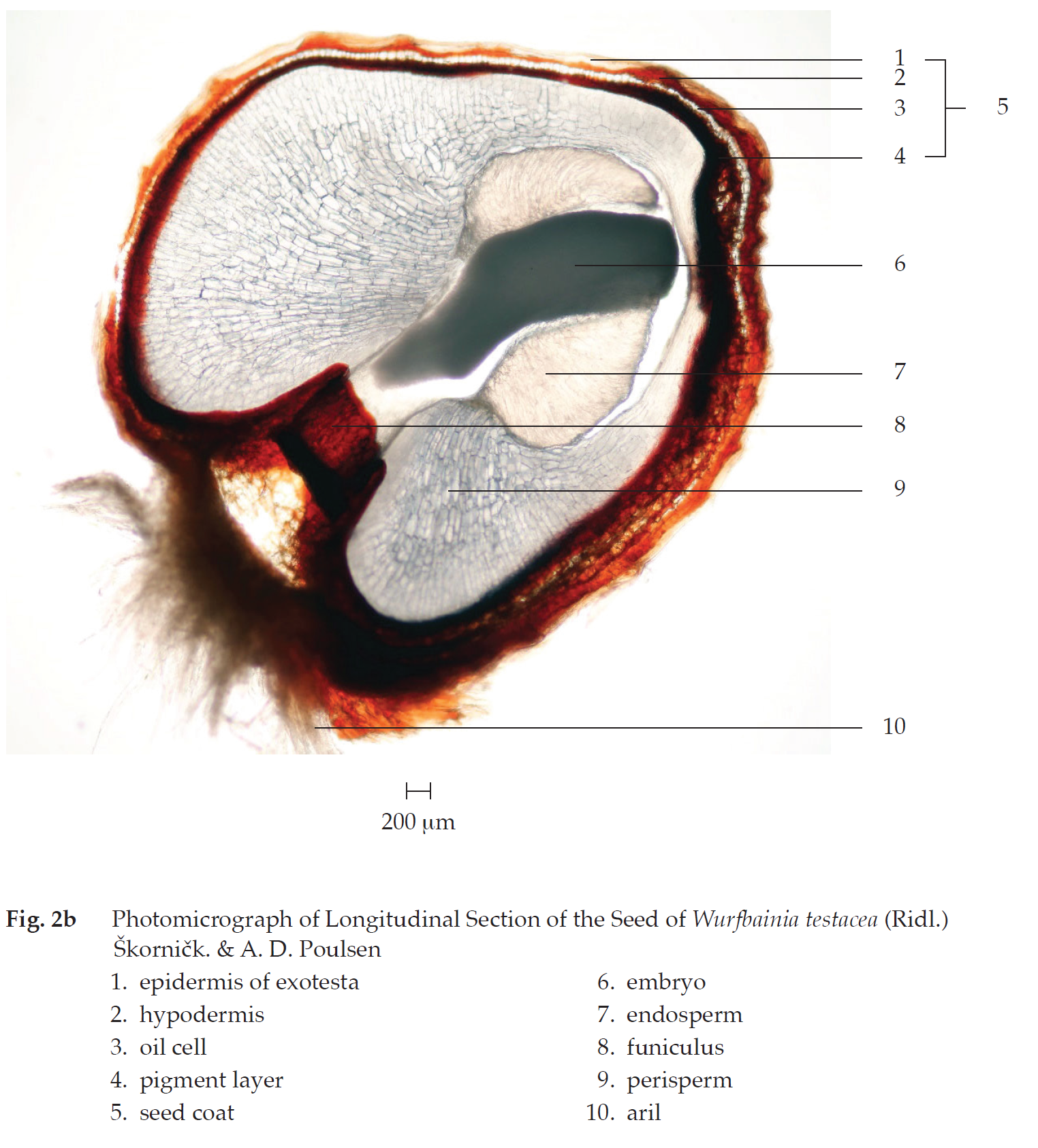
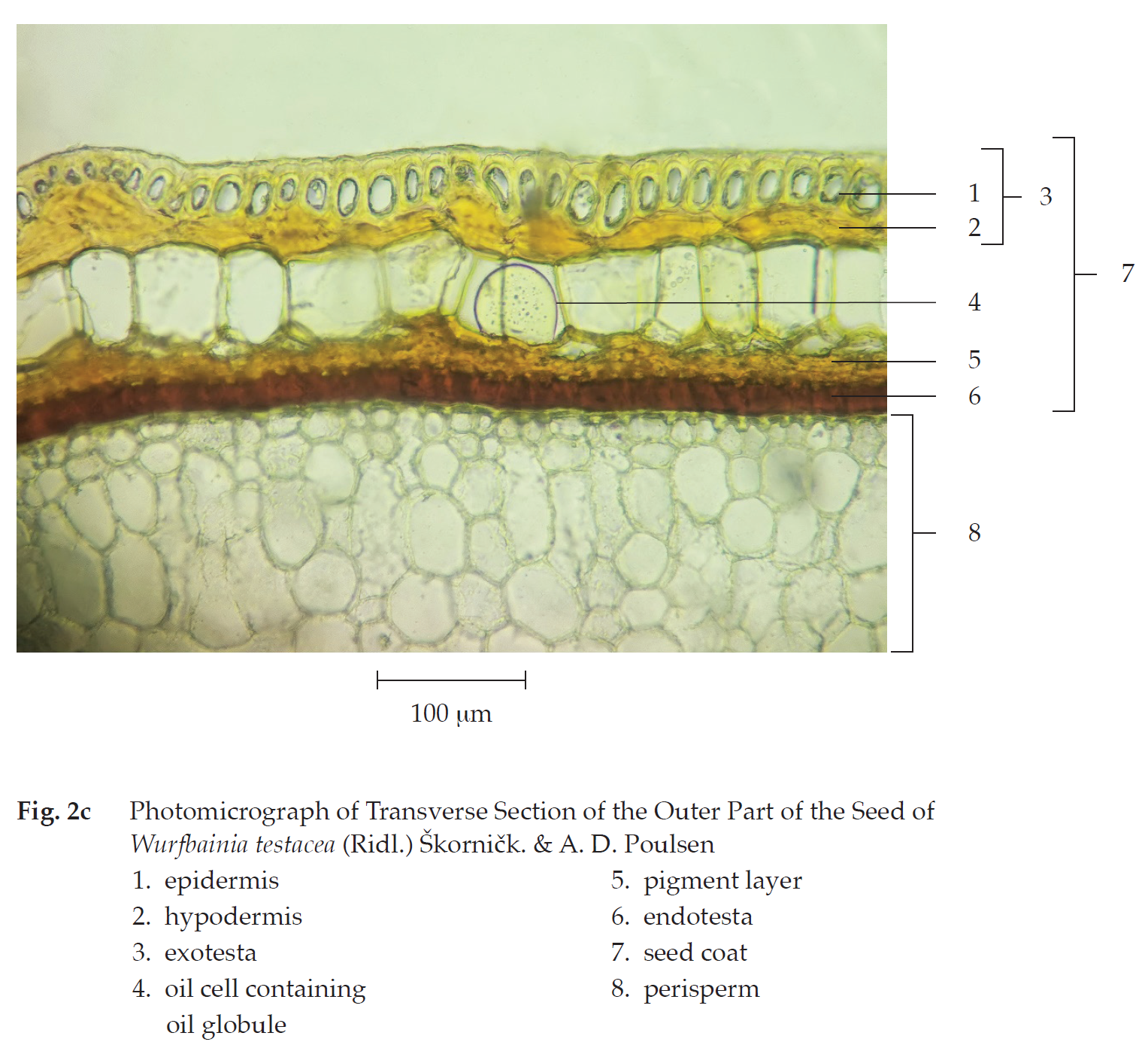
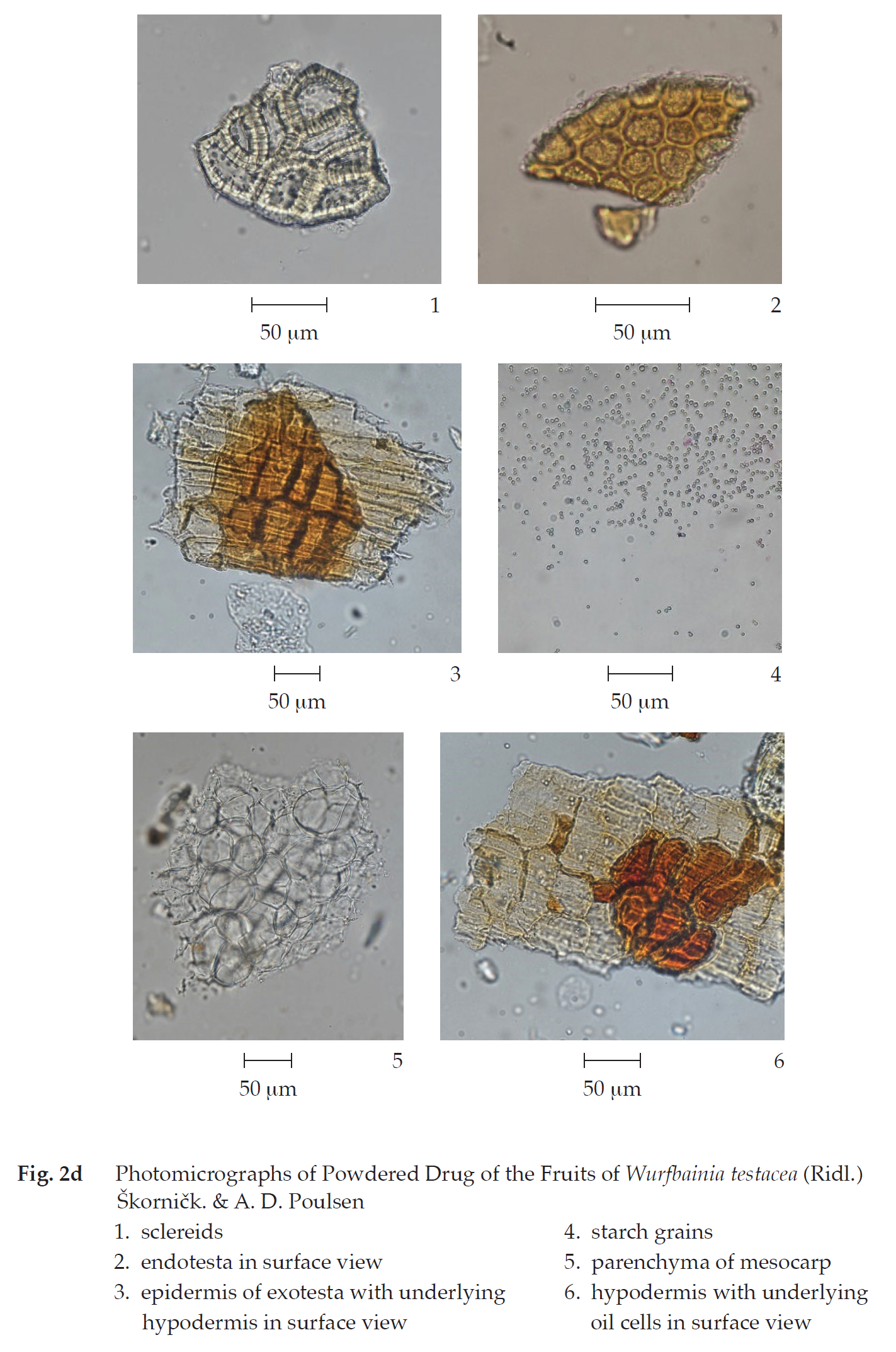
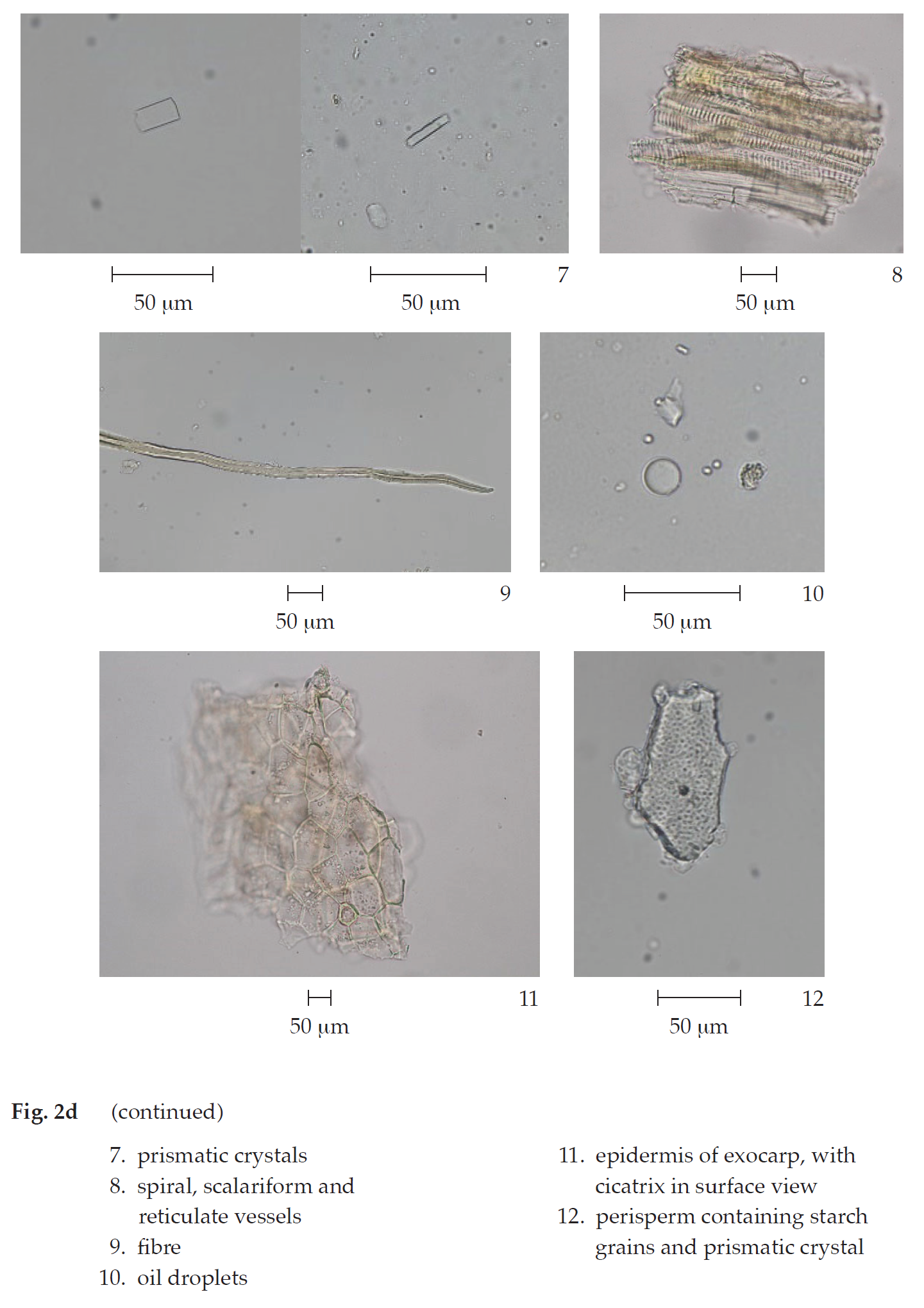
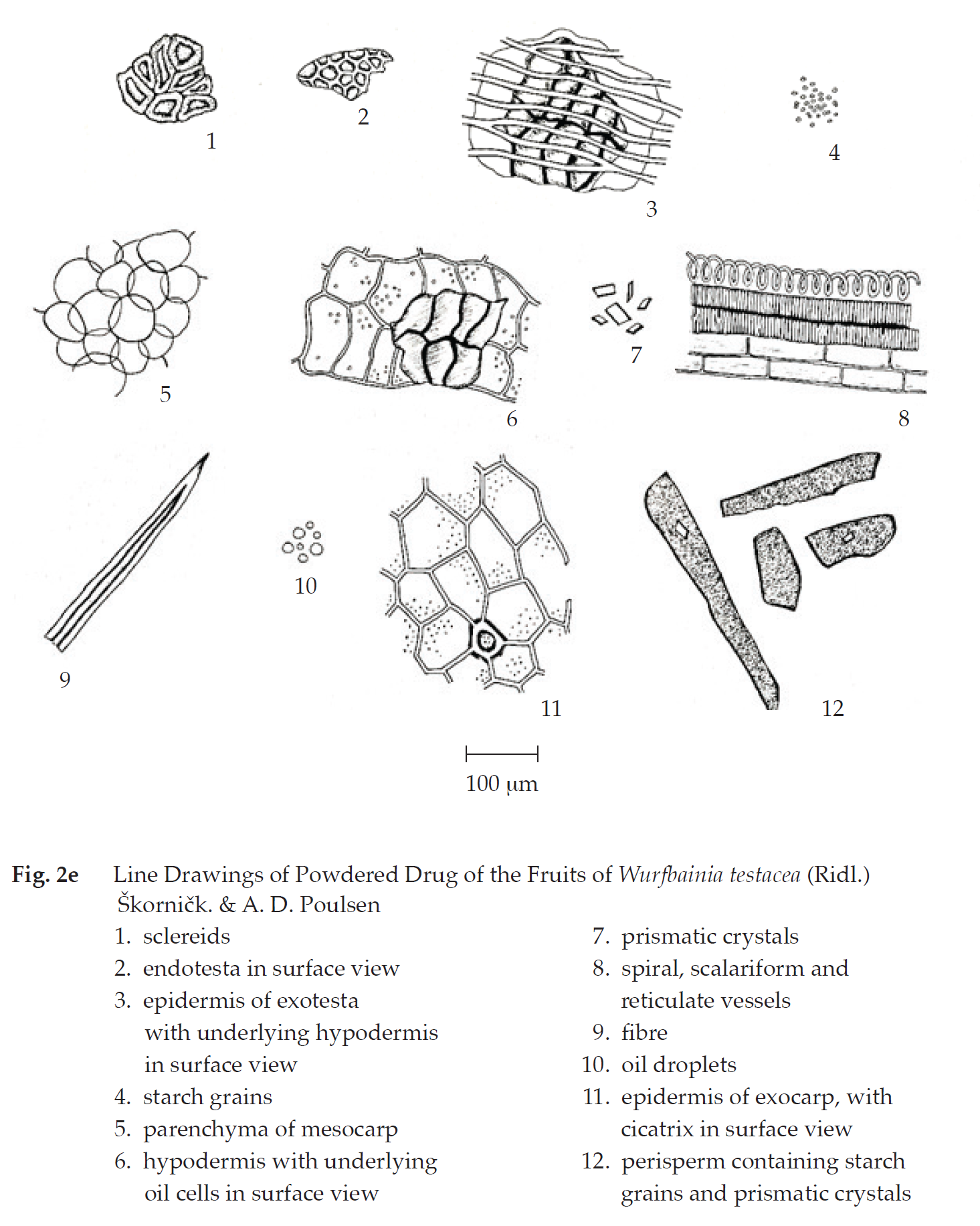
Transverse and longitudinal sections of the seed show seed coat, perisperm, endosperm, embryo, and funiculus. Seed coat: exotesta, a layer of radially elongated epidermis and a few layers of reddish brown hypodermis; a layer of large thin-walled subrectangular oil cells and 2 to 4 layers of dark reddish brown thin-walled polygonal cells; endotesta, a layer of palisade-like sclerenchyma cells. Perisperm: parenchyma containing numerous small starch grains and some containing prismatic crystals. Endosperm: parenchyma containing oil droplets. Embryo: numerous thin-walled parenchyma. Funiculus: dark brown parenchyma
cells.
Siam Cardamom in powder possesses the diagnostic microscopical characters of the unground drug. Epidermis of seed coat with underlying hypodermis and hypodermis with underlying oil cells are characteristic.
Packaging and storage Siam Cardamom shall be kept in well-closed containers, preferably of metal or glass, protected from light and stored in a cool and dry place.
Identification
A. Sonicate 2 g of the sample, in coarse powder, with 10 mL of methanol for 30 minutes and filter. To 2 mL of the filtrate, add a few drops of ninhydrin TS and heat on a water-bath: a violet colour is produced.
B. Carry out the test as described in the “Thin-Layer Chromatography” (Appendix 3.1), using silica gel 60 F254 as the coating substance and a mixture of 90 volumes of n-hexane and 10 volumes of ethyl acetate as the mobile phase. Apply separately to the plate as bands of 6 mm, 20 µL of solution (A) and 2 µL of solution (B). Prepare solution (A) by sonicating 1 g of the sample, in coarse powder, with 3 mL of dichloromethane for 20 minutes and filtering. For solution (B), mix 10 µL of 1,8-cineole with 1 mL of dichloromethane. After removal of the plate, allow it to dry in air and examine the plate under ultraviolet light (254 nm), marking the quenching bands. Examine the plate under ultraviolet light (366 nm); two blue fluorescent bands are observed. Subsequently spray the plate with vanillin-sulfuric acid TS3 and heat at 110° for 10 minutes. The chromatogram obtained from solution (A) shows a blue band (hRf value 48 to 58) corresponding to the 1,8-cineole band obtained from solution (B). Several other bands of different colours are also observed (Table 1); see also Fig. 3.
Table 1 hRf Values of Components in Dichloromethane Extract of the Fruits of Wurfbainia testacea (Ridl.) Škorničk. & A. D. Poulsen
| Band | hRf Value | Detection | ||
| UV 254 | UV 366 | Vanillin-Sulfuric Acid TS3 |
||
| 1 | 12-16 | weak quenching | - | blue |
| 2 | 15-20 | - | blue | - |
| 3 | 21-25 | weak quenching | - | pale grey |
| 4 | 30-32 | - | - | pale grey |
| 5 | 40-45 | - | light blue | - |
| 6* | 48-58 | - | - | dark blue |
| 7 | 72-78 | - | - | grey |
*1,8-cineole
Water Not more than 11.0 per cent v/w (Azeotropic Distillation Method, Appendix 4.12).
Foreign matter Not more than 2.0 per cent w/w (Appendix 7.2).
Acid-insoluble ash Not more than 3.0 per cent w/w (Appendix 7.6).
Total ash Not more than 10.0 per cent w/w (Appendix 7.7).
Water-soluble extractive Not less than 6.0 per cent w/w (Appendix 7.12).
Volatile oil Not less than 4.0 per cent v/w, calculated on the anhydrous basis (Appendix 7.3H). Use 15 g, in coarse powder, freshly prepared and accurately weighed. Use 250 mL of water as the distillation liquid and a 500-mL round-bottomed flask. Add 1 mL of silicone antifoam (30 per cent) to the sample in the flask. Distil at a rate of 2 to 3 mL per minute for 4 hours. Use 2.0 mL of xylene in the graduated tube.
